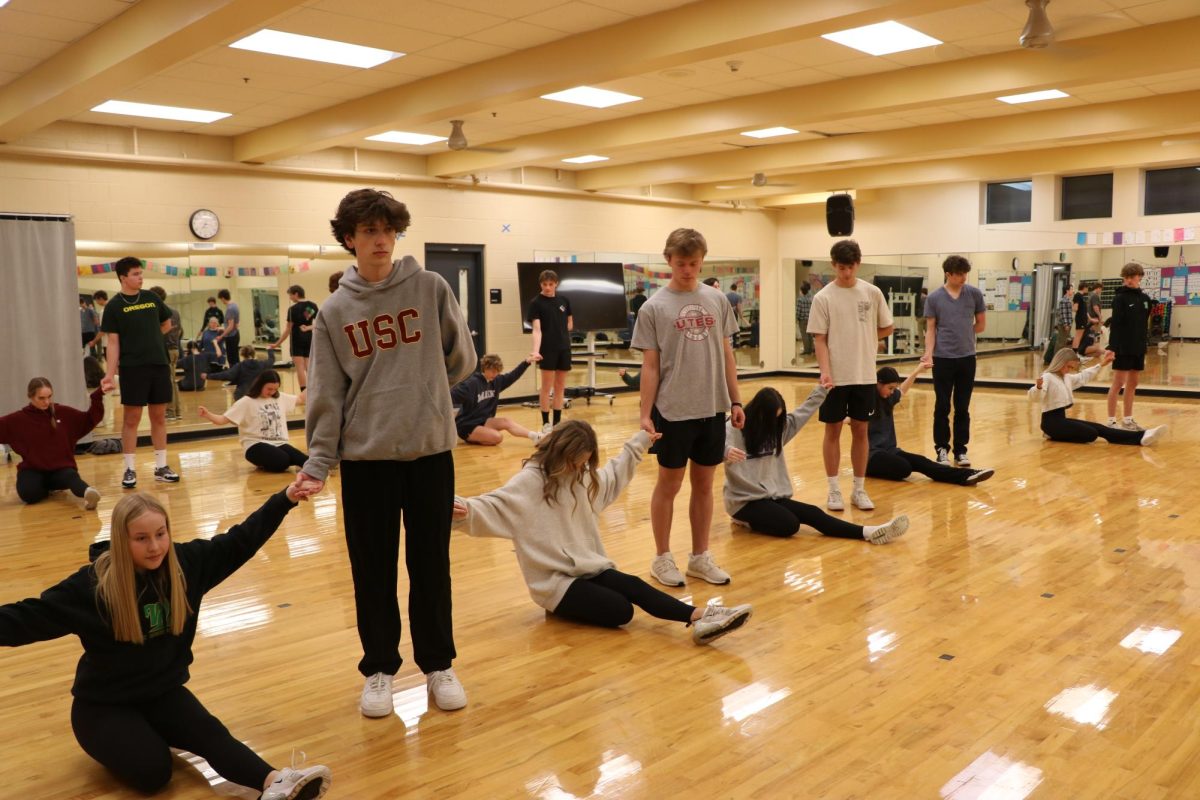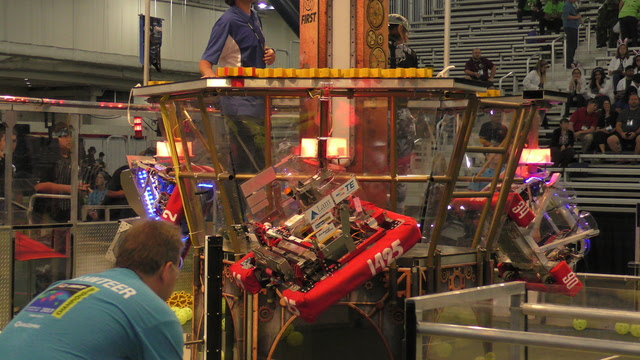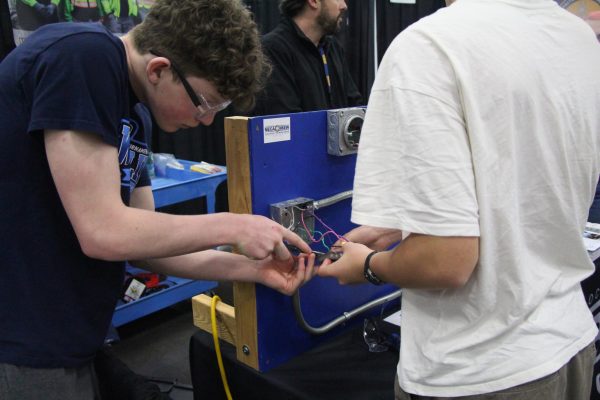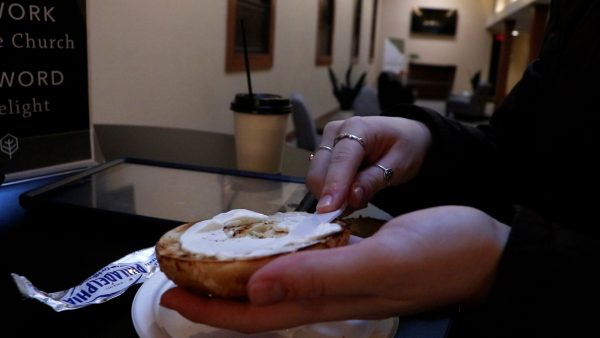Building history
Robotics team success this year leads to world championships
The robotics team qualified for worlds after competing in two district competitions and a district championship. “During a competition,” Benjamin Chan, junior, said. “Teams play twelve qualification matches, to raise their average ‘ranking score’, which is points cumulated from wins, losses, ties, and bonus points from special objectives. Between matches, a ‘pit crew’ works on fixing and maintaining the robot, checking for vital flaws, and running system checks to insure optimal performance. After regionals or district champs, the top teams qualify for the world’s competition, to which they must transfer their tools, robot, batteries, and other equipment.”
Building as fast as they can is how the robotics team starts off their season. After the limited amount of building time, the team then can’t touch their robot outside of strictly monitored time periods.
“The official robotics season starts on the first or second Saturday of each year.” Benjamin Chan, junior, said. “An international video is broadcast live to announce the ‘challenge’ of the year, a unique and different series of objectives that we must design and build a robot to solve. We then get six weeks to design, code, and fully build the 120 pound robot. Once build season ends, we put the robot in a sealed plastic bag, where we cannot touch it- except for strictly timed ‘un-bag windows’- until our competitions.”
To get the robot done in time, the team must be very organized. They delegate different roles to people so the team works as efficiently as possible.
“For robotics meetings the team is split up into 6 different sub teams.” Beth Hoots, senior, said. “Each one functions like a department of a business, so the software department works on the robot’s code, the mechanical department does design and fabrication, marketing plans business presentations, outreach, and fundraisers, electrical team wires the robot and makes sure we have power, scouting tracks what other teams are doing across the world, and strategy breaks down the game so we can maximize our scores with our robot.”
After multiple competitions, the team qualified to go to the world championships.
“Worlds is an incredible experience because of the huge robotics community.” Hoots said. “Teams from all over the world come together to compete across cultural and language barriers in a challenge that drives the technological advancements of the future. All of these teams are doing amazing things, and I’ve made great friends through robotics.”
Worlds took place on April 18-22 in Houston, Texas. While there are 47 members of the team, only about 23 students along with adult mentors and teachers attended the competition.
“It was my first time going to worlds,” Helene Brehl, freshman, said. “I didn’t really know what it would be like but I was really excited just to see different teams from different parts of the world. There were teams from Turkey and Israel and a couple teams from Australia. It was really cool to meet those different teams.”
While the team has qualified for the world competition multiple times, they still work their hardest to be able to continue qualifying.
“Our team has had a growing influence over teams in the area,” Chan said. “and we’ve come to be known as the one of the ‘powerhouse’ teams in the Pacific Northwest District, as we’ve now made it to worlds every year since the 2015 season. Expectations were high this year, and I personally think that we met them. We not only won one of our district events, but we were also able to receive awards for entrepreneurship, industrial design, and gracious professionalism.”
This high level competition, comes with a high level of stress.
“Competition at the world level can be incredibly difficult since all of the teams are already very successful.” Hoots said. “Our robotics team has never made it to the final competition field- named Einstein field in keeping with the tradition of naming the competition fields after impactful scientists- so it’s always exciting and a little nerve-wracking to think about whether this could be the year we make team history.”
However, the team ended up being successful at worlds.
“We got to quarter finals again,” Brehl said. “But we were in the hardest field. In worlds there are six fields to split up the teams because there are 400 to 500 teams there. They have these different fields so matches can happen at the same time.”
Your donation will support the student journalists of West Linn High School. Your contribution will allow us to continue to produce quality content by purchasing equipment, software, and continuing to host our website on School Newspapers Online (SNO).

Purple, swollen and bruised was the state of Lauren Sandberg’s, sophomore, leg. Due to a fall in dance class, Sandburg sprained her ankle.
“I couldn’t...


























![Game, set, and match. Corbin Atchley, sophomore, high fives Sanam Sidhu, freshman, after a rally with other club members. “I just joined [the club],” Sidhu said. “[I heard about it] on Instagram, they always post about it, I’ve been wanting to come. My parents used to play [net sports] too and they taught us, and then I learned from my brother.”](https://wlhsnow.com/wp-content/uploads/2024/03/MG_7715-2-1200x800.jpg)





![The teams prepare to start another play with just a few minutes left in the first half. The Lions were in the lead at halftime with a score of 27-0. At half time, the team went back to the locker rooms. “[We ate] orange slices,” Malos said. “[Then] our team came out and got the win.”](https://wlhsnow.com/wp-content/uploads/2023/10/IMG_2385-1200x800.jpg)





![At the bottom of the third inning, the Lions are still scoreless. Rowe stands at home plate, preparing to bat, while Vandenbrink stands off to the side as the next batter up. Despite having the bases loaded, the team was unable to score any runs. “It’s just the beginning of the season. We’re just going to be playing out best by June, [and] that’s where champions are,” Rowe said.](https://wlhsnow.com/wp-content/uploads/2024/03/IMG_3077-1200x900.jpg)













































































